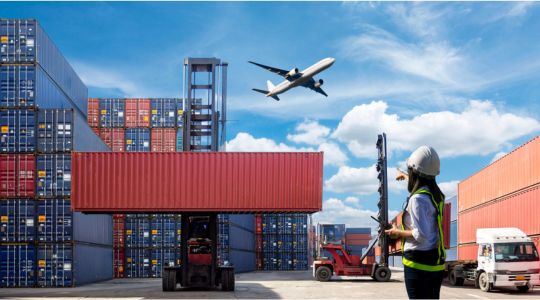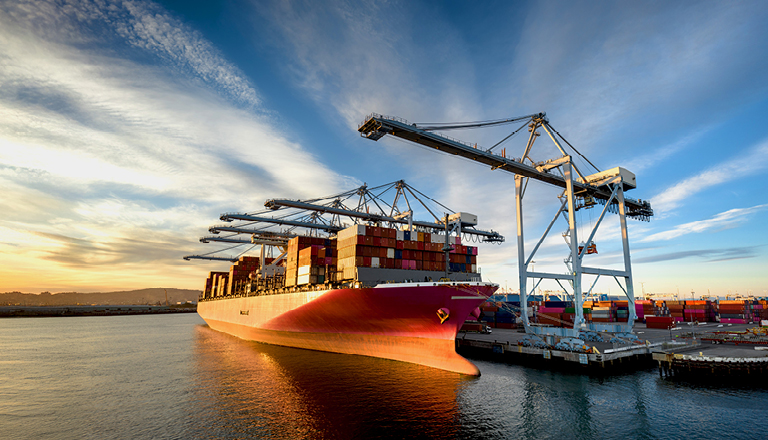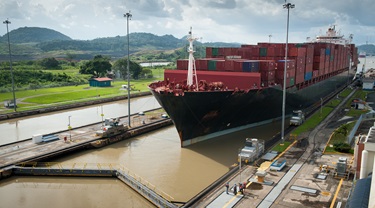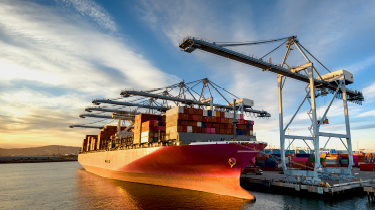Optimizing supply chains to mitigate risks of global trade
The resiliency of an exporter’s ability to turn a profit is forged, link by link, in the strength of a company’s supply chain.
Yet, even the most robust supply chains are tested by changing geopolitics, environmental threats and shifting global trade.
For Canadian exporters in the international marketplace, assessing risk and developing strategies for supply chain optimization are critical steps for two key reasons:
1. To get your products to buyers on time; and
2. To ensure there’s a backup plan in the event of weaknesses in the supply chain.
By proactively addressing vulnerabilities and adopting better practices, businesses can navigate the complexities of international trade with greater confidence and resilience.
From raw materials and finished products to warehousing and delivering to international customers, an export supply chain is made up of many moving and complex parts. Yet, many companies tend to focus on areas immediately related to their business, says Emiliano Introcaso, an Export Development Canada (EDC) trade advisor and senior product operations manager.
“Mapping the supply chain is something that a lot of companies don’t do. If they have a customer, there’s a supply chain to them, but it’s only part of a larger chain of supplies. If they don’t have a proper understanding of the big picture and their part in it, they’re not accurately assessing their risks,” Introcaso says.

It’s underpinned by a strategic framework that continuously incorporates mechanisms for improvement. Solid supply chain management (SCM) should be able to flex through market fluctuations, increased tariffs and duties, or shipping disruptions, and be agile enough to scale up on demand as needed. It also has national and international compliance regulations embedded in everything—from employee training to benchmarking.
For Lisa Fenton, global supply chain and inventory manager at Custom Plastics International, supply chain risk management has grown in complexity and sophistication during her 12 years in the industry. Things like, a growing demand for transparency in addressing environmental and social risks in supply chains. Large companies are increasingly seeking suppliers that actively support their sustainability initiatives and help mitigate risk.
The family-owned business was started in 1965 and supplies plastic injection moulding products to 18 industries, domestically and internationally.
“When I first started in supply chains, there wasn’t any emphasis on geopolitical environments or risk analysis. It was pretty much a tactical position,” recalls Fenton.
“But the focus has changed to prioritizing any kind of risk—assessment of suppliers, operational, geopolitical, logistical and business contingencies, as well as cybersecurity, regulatory compliance, environmental and financial risks,” she says.
“These days, it’s much more of an analytical strategy partner role where you have to be ready for anything and everything.”
The key to managing risk starts with targeting where it exists in the supply chain, building in support and uncovering opportunities in the gaps.
Here are some common types of supply chain risks:
1. Shipping and transportation
2. Duties, tariffs and diversification
3. Cybercrime
1. Shipping and transportation
Getting products to market is more than filling containers on ships; it's also understanding that global transportation can be a game where the rules change frequently and on short notice.
Having a trusted freight forwarder familiar with Canadian exporting is essential, as they can coordinate each trade lane required for your supply chain. A reliable freight forwarder also leverages international partnerships to find the best deals, especially for smaller shipments.
Shipping delays, whether due to congested ports or inefficiencies in the logistical network, can cause pain in delivery, warehousing and holding costs. Natural disasters, like earthquakes, floods, or hurricanes, can also cause prolonged interruptions. That’s why it’s important to build redundancy into the system, like alternative routes and sourcing from diverse markets, when possible, says Introcaso.
“If you’re sourcing materials at a distance, the cost of the product may be very economical, while the amount of time it takes, cost of shipping and duties might be higher,” he explains. “If you choose a closer market, or engage in nearshoring, it may be more expensive to source the product, but the risk and landed cost will be less.”
It also pays to approach weaknesses in transportation with an eye to opportunity, adds Fenton. During the pandemic, when shipping was costly and slow, she did a transportation analysis and to her surprise, air freight wasn’t the more expensive option.
“We got our products to customers cheaper and sooner. That kind of gap analysis and really drilling down into the numbers highlights opportunities that you might not have considered,” she says.
Tip: Exporters exploring freight options can search by name, carrier code and city in the Canadian International Freight Forwarders’ (CIFFA) membership directory. EDC also offers InList which showcases a listing of vetted service providers.

2. Duties, tariffs and diversification
As some countries and even regions swing from globalization to protectionism, taxes and duties on exports and imports fluctuate, making the flow of goods across borders more expensive. Exporters with agile supply chain optimization can pivot away from tariffs and customs barriers towards countries sharing free trade agreements (FTA) with Canada.
Exporters tied to a single market understand that a lack of diversification in suppliers, markets, or production locations makes supply chains vulnerable to local disruptions. Diversifying markets and suppliers acts as a buffer, spreading the risk across different geographies and sectors.
“Obviously, diversifying into markets that have a direct agreement, like Chile, Costa Rica, or through a group free trade agreement, is a way of ensuring you get your best bang for your buck,” says Introcaso.
Canada currently has 16 in-force FTAs, including:
- Canada-United States-Mexico Agreement (CUSMA)
- Canada-European Union Comprehensive Economic and Trade Agreement (CETA), which eliminates 98% of tariffs on non-agricultural Canadian goods
- Comprehensive and Progressive Agreement for Trans-Pacific Partnership (CPTPP), which involves 11 countries with 500 million potential customers.
- Other country-to-country FTAs cover the United Kingdom, South Korea, Honduras, Panama, Jordan, Colombia, Peru and many others.
Exporters looking to expand or search for alternative markets can access a list of in-force FTAs.
3. Cybercrime
Cybercrime and data theft have made consistent headlines over the past few years and continue to impact individuals, industry and governments daily.
According to CrowdStrike’s 2024 cybersecurity report, cloud intrusions have increased by 75% year-over-year. For exporters, cybercrime disrupts operations with system downtime, data breaches and supply chain breakages, leading to profit loss and reputational damage.
While the sprawling nature of supply chains make them vulnerable at multiple points, you can mitigate the risk. A few strategies include investing in VPNs and data encryption, a third-party risk assessment, robust cybersecurity infrastructure and employee training, as well as ensuring you’re compliant with data privacy laws in export markets.
The Canadian federal government has also released its $37.8 million National Cyber Security Strategy, which takes a whole-of-society approach to address cross-border critical infrastructure, as well as domestic risk. The Canadian Centre for Cyber Security also has awareness and risk management tools.
Explore how to strengthen supply chains, control rising costs and stay on track during uncertain times.
You should also check out
Explore how to strengthen supply chains, control rising costs and stay on track during uncertain times.
Optimizing a supply chain isn’t just about trimming expenses—it’s how you craft a resilient, flexible network that can thrive amid constant change. It’s also about building strong relationships and laying out where the relationships exist and how they work.
From where materials are sourced to where they’re held and how they end up in the hands of consumers, having eyes on every link in the supply chain helps exporters understand compliance, how to navigate tariffs disruptions or demand surges and how to see vulnerabilities before they become problems.
Here are some supply chain optimization methods:
1. Supply chain mapping
2. Leverage generative AI and automation technology
3. Invest in best practices and training
4. Understand compliance and regulation
5. Contracts, Incoterms and insurance
6. Build a key performance indicator (KPI) dashboard
1. Supply chain mapping
Mapping starts with identifying all suppliers across every tier—not just the immediate ones. This includes understanding sub-suppliers, as risks can often originate deeper within the chain.
Supply chain consultants, or internal teams overseeing the mapping process, should include an evaluation of the geographic locations of all partners to assess regional risks such as political instability, natural disasters, or infrastructure challenges.
Equally important is using data from transportation modes, lead times and inventory to map the flow of materials to identify dependencies and weak links. Finally, mapping compliance requirements and regulatory obligations for each jurisdiction ensures adherence to international and national laws.
For Fenton, who manages a small team, the biggest opportunities to optimize her supply chain were found internally, by identifying inefficiencies and kickstarting new processes with a toolkit of software, automated reports and flags.
“When you’re a one- or two-person team, you really need to be super efficient. I created reports for other departments that would benefit the supply chain, as well,” she explains.
“A lot of the time, supply chain people sit in their silo. But you must break out of it to create efficiencies for your stakeholders and your customers, who are not just end-to-end, but also internal customers, like the other departments whose efficiencies are connected to your own.”
2. Leverage generative AI and automation technology
For example, real-time data analytics and key performance indicators (KPIs) can quickly identify bottlenecks and inefficiencies. Adopting tech, like enterprise resource planning (ERP) software that collects, stores, and analyzes data, will further streamline processes ranging from finance and manufacturing to inventory and sales.
A report on the use of AI models in supply chain management by the IBM Institute for Business Value reported:
- 79% of executives said Gen AI is useful for optimizing inventory management by predicting future demand patterns.
- More than 80% of respondents said AI’s predictive capabilities led to earlier detection of problems.
- 77% said AI models also helped trigger proactive measures by successfully identifying geopolitical and climate risks.

For exporters considering some, or all of these strategies, it’s important to ensure data is clean, privacy and security protocols are established and staff are fully trained. You can explore more about how Gen AI can help your business in our webinar, Embracing AI to enhance global business growth.
3. Invest in best practices and training
While AI may require significant investment in training, overall workforce development can improve supply chain operations. A skilled and adaptable team is better equipped to implement new technologies and innovative processes effectively.
Implementing data-driven continuous improvement methodologies, like Six Sigma or Kaizen, cultivates a culture of excellence because employees are empowered to identify opportunities for optimization at every level.
By viewing the supply chain as a dynamic, interconnected ecosystem rather than a linear process, businesses can adapt swiftly, harness new opportunities and achieve a level of optimization that propels them ahead of the competition.
Exporters should be aware of regulations like the EU’s Green Deal, focused on sustainability and climate goals, and the Indo-Pacific’s frameworks like Australia’s Modern Slavery Act, which addresses human rights in supply chains. Complying with these regulations helps ensure market access and alignment with international standards.
4. Understand compliance and regulations
Navigating customs at the border and being compliant with reporting are critical for exporting, but that’s expanded significantly in complexity, says Fenton.
While customs compliance may get your goods across borders on time, importing nations and organizations may require additional regulations to be met, partly for oversight and possibly as a means of collecting fees. Understanding those regulations and establishing practical workbacks for gathering and filing information may take more time, but it’s essential.
“Regulatory compliance requests seem to be more frequent than in the past for customers and vendors alike,” she says. “Analysis and requests for additional information are also increasing and may need exporters to devote more resources to managing compliance issues, as they are highlighted more than ever.”
Canadian exporters could consider creating their own regulatory and compliance program, in which regulations are integrated into their processes as early as market research and R&D stages.
Conducting continuous risk assessments, compliance training and end-to-end export compliance security and monitoring are all proactive measures that increase resiliency in supply chain management.
You can explore compliance and reporting requirements through the Canada Border Service Agency’s online guide and Compliance & logistics: What you don’t know could cost you.
5. Contracts, Incoterms and insurance
At the heart of every container of exported goods lies a contract between supplier and buyer.
Supply contracts are based on a number of variables, many of them defined by Incoterms, three-letter acronyms that clarify the responsibilities of buyers and sellers. Incoterms cover a range of issues such as determining who pays for shipping insurance, who’s responsible for covering duties and how cargo will be unloaded. They are, in short, a language that helps both sides understand the costs, risks and obligations.
Incoterms may provide an understanding of contract terms, but to protect your business, Introcaso says contract clauses need to go much deeper than defining roles and responsibilities.
“For example, you might include DDP—delivered duty pay—as an Incoterm. It defines who pays the duty, but that’s all. If a country imposes new import fees or tariffs, they should be explicitly included in a clause beyond the basic definition of DDP, or the extra costs to the importer won’t be covered,” Introcaso explains.
“Exporters should have very specific clauses in the contract, discussed with legal counsel, that will help them navigate changes as they arise.”
Insurance coverage is another tool exporters can use to protect their goods and investment from non-payment, or a customer’s refusal to accept goods.
With EDC Portfolio Credit Insurance, if a client defaults on an account, refuses to accept goods, terminates the contract before shipment, or there are in-market hostilities that prevent payment, EDC covers up to 90% of insured losses. In many cases, financial institutions are more willing to lend against insured invoices for up to 90% of their value.
EDC Foreign Exchange Facility Guarantee (FXG) is another product that provides a buffer against foreign exchange risk without committing your capital.
6. Build a key performance indicator (KPI) dashboard
If there’s a benchmark, target or dataset, there’s probably an export KPI to help manage and elevate supply chain performance.
Whether it’s tracking inventory levels, order fulfillment rates, warehousing or lead times, well-designed KPI sets are key to identifying bottlenecks and inefficiencies. By continuously monitoring these indicators, exporters can quickly detect and address issues that may cause disruptions such as delayed shipments or stock shortages.
By aligning KPIs with business objectives, exporters can focus on improving critical areas such as supplier performance, cost control, and delivery accuracy. For example, tracking on-time delivery rates and supplier lead times can help identify reliable partners and optimize sourcing strategies.
Whether tweaking or overhauling a supply chain to ensure its resiliency, Fenton says the payoff is worth the effort.
“Most of us in exports are rushing through the day, so we don’t think about possible opportunities that bring a lot more value and return to your company,” she says.
“Optimizing the supply chain frees up your team from doing tactical activities, so they have more strategic time for analysis. You see cost reductions, faster operations and far more resiliency,” she adds.
“As you adopt more strategies, it also results in cleaner data—and maybe more openness to adopting different ways of doing things.”
Canadian exporters looking for support, answers and insight into supply chain management have EDC’s team of experts on hand to help. For more background and insights, watch EDC’s recent webinar, Stronger links: Managing your global supply chain.
EDC’s Export Help Hub is a resource offering Canadian exporters answers to the most frequently asked questions about global trade to help grow your business.
EDC is part of Canada’s trade team, an interconnected group of federal government partners that work together to support your international growth. Whether you need financing strategies, solutions to overcome risk, access to market intelligence, or introductions to solidify your in-market presence, we can help.
With EDC, Canada’s trade team includes the Business Development Bank of Canada (BDC), Canadian Commercial Corporation (CCC), Innovation, Science and Economic Development Canada (ISED) and the Trade Commissioner Service (TCS).
We’re deploying $5 billion in capacity to support Canadian exporters.
Check out our Trade Impact Program





